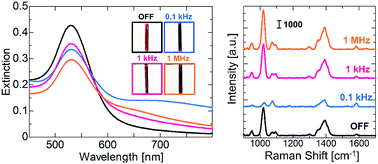The plasmonic properties of gold nanoparticle clusters formed via applying an AC electric field†
Abstract
An external electric AC field with a field strength ranging from 10 V mm−1 to 30 V mm−1 and a frequency ranging from 0.1 kHz to 1 MHz was applied to suspensions of gold nanoparticles (Au NPs) to control their plasmonic properties. Apparent differences in the UV-vis spectra of the Au NPs were observed between the spectra with and without the field application. The characteristic red color of the Au NP suspension darkened; this suggested that the application of the AC field caused the aggregation of the Au NPs. In addition, the sizes of the Au NP clusters in suspension formed by the AC field application depended on the frequency of the applied field. The surface-enhanced Raman scattering (SERS) effects of Au NP clusters were examined by comparing the difference in Raman intensities obtained at 30 V mm−1 and in a frequency range of 0.1 kHz to 1 MHz. The application of a low-frequency field at 0.1 kHz caused a rapid aggregation of the Au NPs, resulting in low Raman intensities of the probe molecules. Conversely, high-frequency applications between 1 kHz and 1 MHz successfully enhanced the Raman intensities of the molecules in suspension. The strong correlation of the optical/sensing properties with the Au NP clustering states reveals that the application of an AC electric field is a powerful tool for control over the plasmonic properties.



 Please wait while we load your content...
Please wait while we load your content...